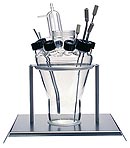
Exceptional volume range in one instrument
As there has been a lot of progress in analytics and sample preparation methods it is now possible to use, with advantages, much smaller volumes of media in smaller vessels than it was before. The MINIFOR fermenter-bioreactor has been conceived so that reliable results can be now obtained in much lower volume than before. No need to use 14, 10, 7, 5, 3 l vessels to study and optimize the living conditions of the cellculture. This can be successfully done in just one liter vessel. The MINIFOR fermentor/bioreactor allows you to work with volume ranging from 35 ml to 6 liters in one single instrument.
- small volumes of medium are faster sterilized, cooled down and are ready in less time
- less medium costs
- in MINIFOR a higher volume of sample can be withdrawn without any effect on the quality of regulation
- to increase productivity continuous cultures are possible. Minifor is ready to receive an optional scale module (channel X)
- lower downstream costs
- lower disposal costs
Main advantages for the work with low volumes:
- Easy and precise control of the process parameters
- Shorter sterilization times
- Smaller (and cheaper) autoclaves can be used for sterilization
- Shorter medium heating and cooling times
- Cost savings in culture media
- Cost savings in the downstream processing and equipment
- Easy elimination of unused medium and lower disposal costs
- The possibility of continuous culturing increases the productivity by at least one order of magnitude, thus you can get the same biomass at much lower vessel volumes (see Easy weight control for continuous cultures)
To fully benefit from these advantages we recommend the use of 1L or 3L volume vessels or less.
| Vessel type: | 0.3 | 0.4 | 1 | 3 | 7 |
 |
 |
 |
 |
 |
|
| Volume [L]: *) |
0.035-0.4 | 0.15-0.45 | 0.3-1.7 | 0.5-3 | 1-6 |
| Height [cm]: **) |
34 | 22 | 34 | 37 | 50 |
| Diameter [cm]: **) |
22 | 23 | 25 | 34 | 30 |
*) Volume: approximate minimal and maximal working volumes. May vary according to the conditions of each application.
**) Height + Diameter: approximate dimensions of the vessel for autoclaving with typical accessories. May vary according to the conditions of each application.
More about project stages in biotechnology
Biotechnology praxis shows that there are basically three stages on the way from an idea to an industrially produced biotechnological product: the laboratory scale, the scaling-up or pilot scale and the production or industrial stage:
1. Research on the laboratory scale
The goal is to select the right organism for the production, optimize living conditions of the strain to obtain the best possible growth and/or productivity. At this stage all possible growth conditions and factors are studied.
In short, the objective is to find the optimal living and/or production conditions of the selected organism. At this laboratory stage, one should work with lowest possible volumes and practical vessels. This leads to decreased costs of media and equipment (e.g. autoclaves, cooling water supplies,...), shorter set up times, sterilization times, heating and cooling times, minimal requirements for downstream processing, easier handling, more precise control of the process parameters, etc.
To get accurate information about the rather complex metabolic behavior of living systems it is recommended to measure all accessible parameters and control them with high precision. The sterility is very important on this laboratory scale and, if it is easy to maintain, this results in a big advantage for the researcher, because it increases the productivity and reliability of the research work.
The vast majority of biotechnology projects are realized at this first laboratory scale level. It is worthwhile not to hurry up at this stage because the laboratory experimental work is much less expensive than the following stages. As there has been a lot of progress in analytics and sample preparation methods it is now possible to use, with advantages, much smaller volumes of media in smaller vessels than it was before. There is no use to bother with 5 or more liters of culture volume just to get the same result. The strain does not see the unnecessary large volume around it and when the control is well done it is possible to get perfect results in much lower volumes than it was about ten years ago.
This is the main reason why LAMBDA proposes high quality laboratory bioreactor systems with vessels around one liter. The laboratory fermentor is not a production instrument. An attempt to do so would generally lead only to inefficient use of time, capacity, infrastructure and personnel.
2. Scale up and pilot scale
Essentially, at this stage and scale the goal is to find out and assure the ideal technical conditions, reactors, processes, downstream processing which will come as close as possible to the optimal living and production conditions previously found at the laboratory stage.
In larger volumes, it is not possible to get as good aeration, mixing and, more generally, control of any other parameter as it is on laboratory scale. It is not possible to study technological effects with a vessel of ten liters. At this volume, the technological problems are not visible yet. To see these effects well, much larger volumes are required.
The technical means must be selected in such a way that the culture requirements will be practically realizable on large or very large scale at lowest possible investment and process costs.
The scale-up and pilot stage experiments are at least ten times more expensive than laboratory scale experiments and any filling and amending of knowledge will cost much.
3. Production and industrial scale
Production stage requires very high investment and running costs. Once the production plant has been constructed, it is generally not possible to make modifications or they are extremely expensive. Therefore, it is essential that both laboratory and scale-up stages have been done very well.
Sometimes, researchers at schools and universities have not enough experience in the matter and do not properly distinguish between this goal splitting in the different stages of a biotechnology projects. This can lead to a mix up the respective goals, which then results in higher costs and longer project times. One should always keep this in mind and present it correctly to the researchers, academic staff and also students.
- (c) 2008 - 2025 Lambda Laboratory Instruments | Vytvořila společnost Avager s.r.o.



